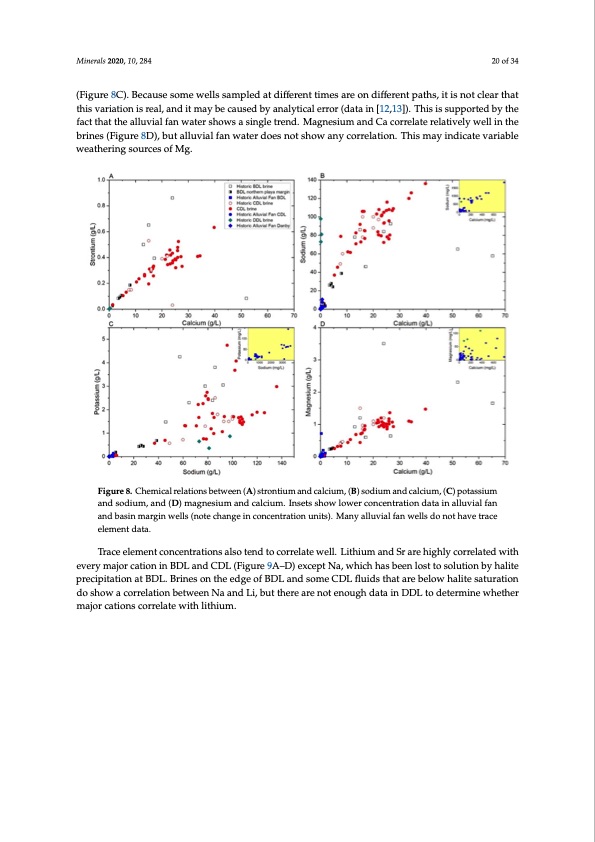
PDF Publication Title:
Text from PDF Page: 020
Minerals 2020, 10, 284 20 of 34 Minerals 2020, 10, x FOR PEER REVIEW 20 of 34 (Figure 8C). Because some wells sampled at different times are on different paths, it is not clear that 8C). Because some wells sampled at different times are on different paths, it is not clear that this this variation is real, and it may be caused by analytical error (data in [12,13]). This is supported by the variation is real, and it may be caused by analytical error (data in [12,13]). This is supported by the fact that the alluvial fan water shows a single trend. Magnesium and Ca correlate relatively well in the fact that the alluvial fan water shows a single trend. Magnesium and Ca correlate relatively well in brines (Figure 8D), but alluvial fan water does not show any correlation. This may indicate variable the brines (Figure 8D), but alluvial fan water does not show any correlation. This may indicate weathering sources of Mg. variable weathering sources of Mg. FigFiugruer8e.8C.hCehmemicaiclarlelraetliaotinosnbsebtwetweeenen(A()As)trsotnrotniutimumanadncdalcailucmiu,m(B, )(Bso)dsioudmiumandancdalciaulcmiu,m(C,)(pCo)tassium potassium and sodium, and (D) magnesium and calcium. Insets show lower concentration data in and sodium, and (D) magnesium and calcium. Insets show lower concentration data in alluvial fan alluvial fan and basin margin wells (note change in concentration units). Many alluvial fan wells do and basin margin wells (note change in concentration units). Many alluvial fan wells do not have trace not have trace element data. element data. Trace element concentrations also tend to correlate well. Lithium and Sr are highly correlated Trace element concentrations also tend to correlate well. Lithium and Sr are highly correlated with with every major cation in BDL and CDL (Figure 9A–D) except Na, which has been lost to solution every major cation in BDL and CDL (Figure 9A–D) except Na, which has been lost to solution by halite by halite precipitation at BDL. Brines on the edge of BDL and some CDL fluids that are below halite precipitation at BDL. Brines on the edge of BDL and some CDL fluids that are below halite saturation saturation do show a correlation between Na and Li, but there are not enough data in DDL to do show a correlation between Na and Li, but there are not enough data in DDL to determine whether determine whether major cations correlate with lithium. major cations correlate with lithium. BDL brines overall are slightly more saline than CDL brines but have also precipitated far more halite than CDL [26], indicating that BDL is more evaporated and evolved than the CDL brine. Boron and F are not correlated in any of the brines (data in [12,13]); Figure 10) and concentrations in the basin-center brines are not much higher than in the alluvial fan water. This suggests that both elements are adsorbed to/precipitate with clay minerals as they get to the playa center.PDF Image | Bristol Dry Lake Brine Compared to Brines from Cadiz

PDF Search Title:
Bristol Dry Lake Brine Compared to Brines from CadizOriginal File Name Searched:
minerals-10-00284-v2.pdfDIY PDF Search: Google It | Yahoo | Bing
Product and Development Focus for Infinity Turbine
ORC Waste Heat Turbine and ORC System Build Plans: All turbine plans are $10,000 each. This allows you to build a system and then consider licensing for production after you have completed and tested a unit.Redox Flow Battery Technology: With the advent of the new USA tax credits for producing and selling batteries ($35/kW) we are focussing on a simple flow battery using shipping containers as the modular electrolyte storage units with tax credits up to $140,000 per system. Our main focus is on the salt battery. This battery can be used for both thermal and electrical storage applications. We call it the Cogeneration Battery or Cogen Battery. One project is converting salt (brine) based water conditioners to simultaneously produce power. In addition, there are many opportunities to extract Lithium from brine (salt lakes, groundwater, and producer water).Salt water or brine are huge sources for lithium. Most of the worlds lithium is acquired from a brine source. It's even in seawater in a low concentration. Brine is also a byproduct of huge powerplants, which can now use that as an electrolyte and a huge flow battery (which allows storage at the source).We welcome any business and equipment inquiries, as well as licensing our turbines for manufacturing.| CONTACT TEL: 608-238-6001 Email: greg@infinityturbine.com | RSS | AMP |